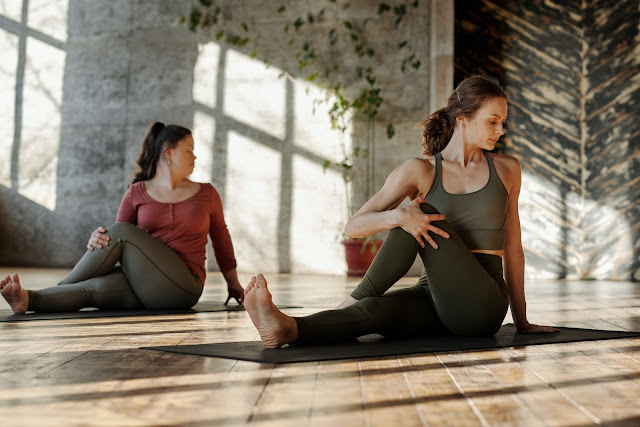Stretching
If you're not sure how to get started, there are plenty of resources available online or at your local library. There are also many classes offered at gyms and community centers as well as physiotherapists. In addition, there are a variety of stretches that can be beneficial for your health. Some good stretches to try include the following:
Hamstring stretch: Sit on the ground with your legs straight out in front of you. Slowly lean forward, reaching toward your toes. Hold the stretch for 30 seconds.
Calf stretch: Stand with your feet shoulder-width apart and your hands on your hips. Step forward with one leg and lower your heel toward the ground. Keep your other leg straight and press down into your heel to feel a stretch in your calf muscle. Hold this position for 30 seconds before switching sides.
Quadriceps stretch: Stand up straight and hold onto a chair or wall for balance. Bend one knee and bring your foot up toward your butt. Using your hand, grab hold of your ankle and pull it gently toward your body. You should feel a stretch in the front of your thigh. Hold this position for 30 seconds before switching sides.
Shoulder stretch: Stand with your feet shoulder-width apart and reach one arm across your chest. Use the opposite hand to grab hold of your elbow and pull it gently toward your body. You should feel a stretch in the back of your shoulder. Hold this position for 30 seconds before switching sides.
Cardio
If you're new to cardio, start with 20-30 minutes of moderate-intensity exercise three times per week. As you become more fit, you can gradually increase the intensity and duration of your workouts. Remember to warm up before you start exercising and cool down when you're finished. This will help prevent injuries and make your workouts more effective.
Strength Training
Start with two or three days of strength training per week. If you're new to strength training, it's important to start slow and gradually increase the amount of weight you're lifting. It would be best if you also focused on using proper form to avoid injuries. As you become more fit, you can add more days of strength training to your routine.
Balance Exercises
Balance exercises are important for improving your balance and coordination. They can also help you prevent falls and reduce your risk of injuries. There are many different ways to do balance exercises, so it's important to find a method that works best for you. For example, you can use a stability ball, practice yoga, or try simple exercises like standing on one leg.
Start with two or three days of balance training per week. If you're new to balance exercises, it's important to start slowly and gradually increase the difficulty of the exercises. It would help if you also focused on using proper form to avoid injuries. As you become more fit, you can add more days of balance training to your routine.
In conclusion, there are many different types of exercises that can help you improve your health. It's important to find an exercise routine that works best for you and that you enjoy. Remember to focus on using proper form to avoid injuries. As you become more fit, you can gradually increase the intensity and duration of your workouts.






.jpg)
No comments
Thanks for your comments, I will try and respond to every one so please check back! :o)